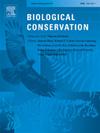南极特别保护物种保护管理工具:发展、使用和未来展望
IF 4.9
1区 环境科学与生态学
Q1 BIODIVERSITY CONSERVATION
引用次数: 0
摘要
通常通过实施相关行动计划来保护特定物种,是国家管辖区域内常用的一种保护工具。南极条约区通过南极条约协商会议(ATCM)接受基于国际共识的管理,该会议于 1964 年首次规定指定南极特别保护物种(SPS)。在过去的 60 年中,只有海狗(Arctocephalus 属)和罗斯海豹(Ommatophoca rossii)被列为 SPS,海狗随后于 2006 年被除名。因此,ATCM 很少使用 SPS 保护工具。成立环境保护委员会 (CEP),是为了就环境问题向南极海生委提供建议。通过其五年工作计划和气候变化应对工作方案,环境保护委员会同意制定管理行动,以维持或改善受威胁物种的保护状况,例如通过动植物卫生检疫措施行动计划。为了帮助环境保护委员会开展工作,我们研究了《南极条约》体系下指定动植物卫生检疫措施的历史,考虑了《世界自然保护联盟濒危物种红色名录》中提供的南极物种当前的保护状况,并考虑了未来如何利用动植物卫生检疫措施保护工具来保护南极生物多样性。考虑将《南极条约》区域内的通心企鹅 Eudyptes chrysolophus 种群指定为 SPS 可能是适当的。不过,帝企鹅 Aptenodytes forsteri 仍应是指定《卫生和植物检疫措施》的优先对象,以尽量减少人类活动对这一易受气候变化影响的物种造成的进一步压力。本文章由计算机程序翻译,如有差异,请以英文原文为准。
The Antarctic Specially Protected Species conservation management tool: Development, use and future outlook
Protection of specific species, generally through the implementation of an associated action plan, is a conservation tool used commonly in areas under national jurisdiction. The Antarctic Treaty area is under international consensus-based governance through the Antarctic Treaty Consultative Meeting (ATCM), which first provided for the designation of Antarctic Specially Protected Species (SPS) in 1964. Over the past 60 years, only the fur seals (genus Arctocephalus) and Ross seal (Ommatophoca rossii) have been listed as SPS, with the fur seals subsequently having been de-listed in 2006. The SPS conservation tool has therefore remained little used by the ATCM. The Committee for Environmental Protection (CEP) was established to provide advice on environmental issues to the ATCM. Through its Five-year Work Plan and Climate Change Response Work Programme, the CEP agreed to develop management actions to maintain or improve the conservation status of threatened species, e.g., through SPS Action Plans. To help the CEP in its work, we examined the history of SPS designation under the Antarctic Treaty system, considered the current conservation status of Antarctic species as provided in the IUCN Red List of Threatened Species and considered how the SPS conservation tool might be utilised in the future to safeguard Antarctic biodiversity. Consideration of SPS designation for the macaroni penguin Eudyptes chrysolophus population within the Antarctic Treaty area might be appropriate. However, the emperor penguin Aptenodytes forsteri should remain a priority for SPS designation in order to minimise further anthropogenic pressures on this climate change-vulnerable species.
求助全文
通过发布文献求助,成功后即可免费获取论文全文。
去求助
来源期刊

Biological Conservation
环境科学-环境科学
CiteScore
10.20
自引率
3.40%
发文量
295
审稿时长
61 days
期刊介绍:
Biological Conservation is an international leading journal in the discipline of conservation biology. The journal publishes articles spanning a diverse range of fields that contribute to the biological, sociological, and economic dimensions of conservation and natural resource management. The primary aim of Biological Conservation is the publication of high-quality papers that advance the science and practice of conservation, or which demonstrate the application of conservation principles for natural resource management and policy. Therefore it will be of interest to a broad international readership.
 求助内容:
求助内容: 应助结果提醒方式:
应助结果提醒方式:


